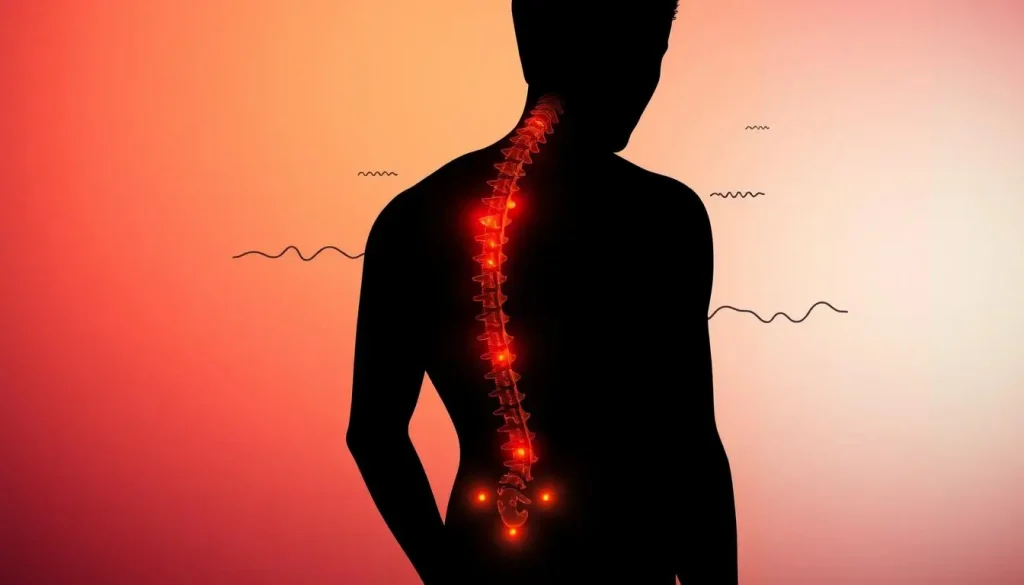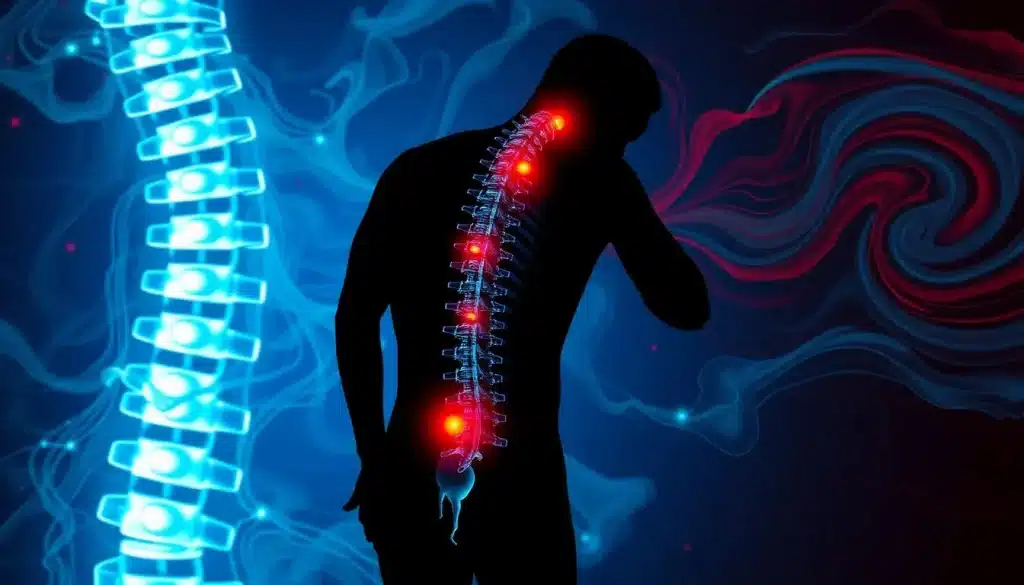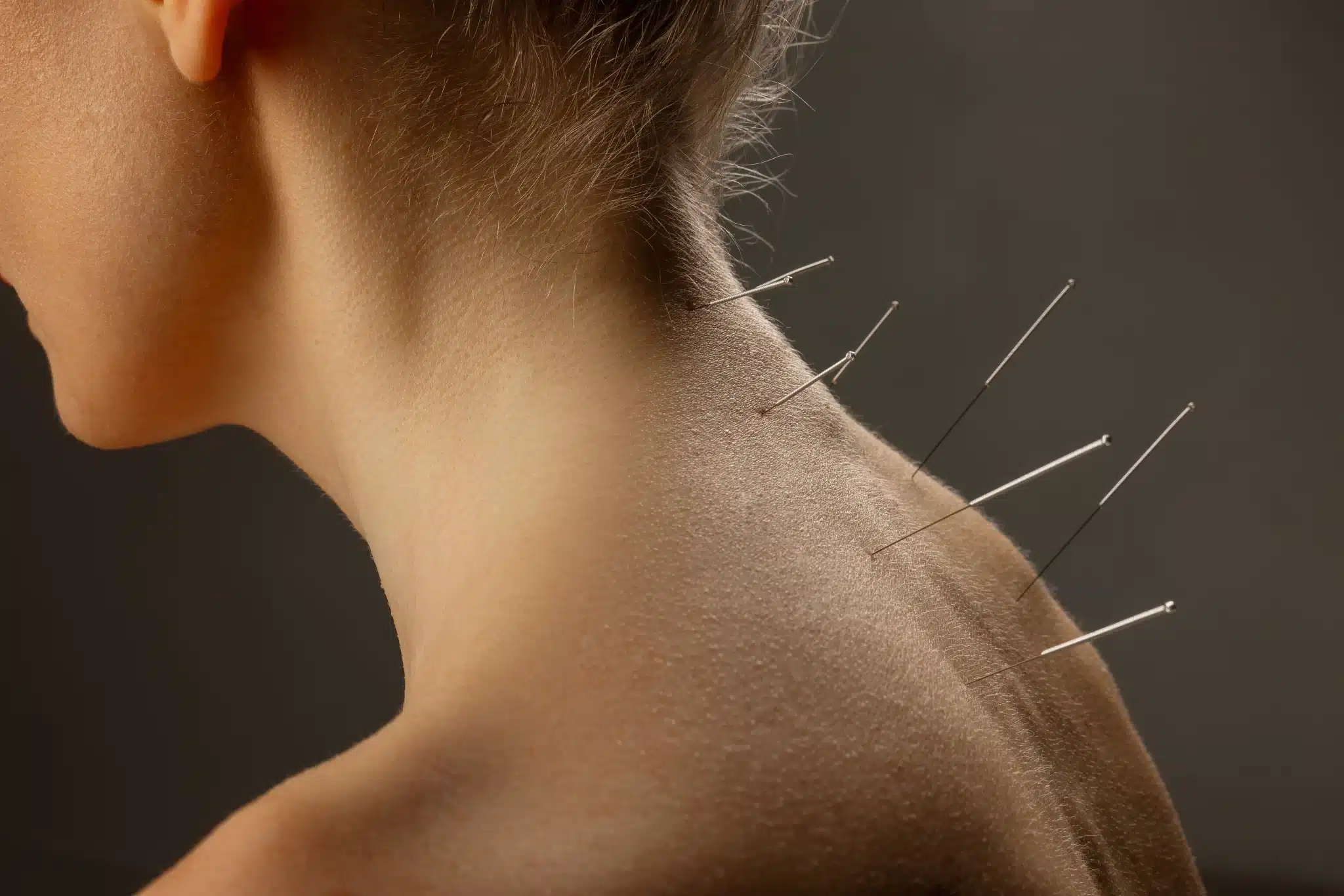Ever felt a deep, burning ache in your lower back? It gets worse when you move or sit for too long. This pain is called vertebrogenic pain. But what is it, and how can you ease it? Let's look into the causes and ways to treat this common back pain.
A stylized illustration of a human spine highlighted with glowing red areas indicating vertebrogenic pain, surrounded by soft waves of blue representing relief, set against a serene natural background with gentle gradients and calming hues.
Key Takeaways
- Vertebrogenic pain is caused by damage to the vertebral endplates in the spine, often due to wear and tear over time.
- Symptoms of vertebrogenic pain include a deep, burning ache in the lower back that worsens with physical activity and prolonged sitting.
- Imaging tests such as X-rays, CT scans, and MRI scans are commonly used to diagnose vertebrogenic pain.
- Treatment options for vertebrogenic pain include medications, physical therapy, and a minimally invasive procedure called basivertebral nerve ablation.
- Maintaining a healthy weight, regular exercise, and avoiding smoking can help reduce the risk of developing vertebrogenic pain.
What is Vertebrogenic Pain?
Definition and Causes
Vertebrogenic pain is a long-lasting back pain caused by damage to the vertebrae's endplates. These endplates connect to the discs between vertebrae. Damage leads to inflammation and pain signals sent to the brain through the basivertebral nerve.
Things like disc degeneration, aging, obesity, and heavy work can harm the endplates. This can cause vertebrogenic pain. Studies show that pain at the L3–S1 levels often feels like mid-line low lumbar pain. It may also spread to the paraspinal and/or gluteal areas.
| Risk Factors for Vertebrogenic Pain |
|---|
| Over the age of 40 Being tall Being obese Being a smoker Doing heavy physical work, like in construction Having a family history of chronic back pain |
Vertebrogenic pain gets worse with bending forward, sitting long, or during activity. Symptoms include deep, aching, or burning pain in the lower back's center. These symptoms can flare up and last over 6 months without getting better.
"In 1966, the source of chronic low back pain (CLBP) could not be identified in 79% of male and 89% of female patients from a general practice population."

A human silhouette outlined against a dramatic backdrop of a spine, with highlighted areas depicting vertebral discs and nerves, surrounded by swirling abstract shapes representing pain and discomfort, using a color palette of deep blues and vibrant reds to convey tension and strain, evoking a sense of anatomical complexity and emotional impact.
Symptoms of Vertebrogenic Pain
Vertebrogenic pain affects nearly 15% of people with chronic low back pain. It's often confused with degenerative disc disease or arthritis. This pain feels like a deep, burning, or aching sensation in the middle of the lower back.
The pain gets worse when bending forward, sitting for a long time, or doing physical activities. Some people also feel pain in the areas around the spine or glutes.
Also, a degenerated disc can cause numbness, tingling, or weakness in the lower body. This is because of the disc's damage.
- Deep, burning, or aching pain in the middle of the lower back
- Pain that worsens with bending forward, sitting for long periods, and physical activity
- Referred pain in the areas around the spine or the glutes
- Numbness, tingling, or weakness in the lower body due to a degenerated disc
It's key to understand the symptoms of vertebrogenic pain for the right diagnosis and treatment. Healthcare experts can then offer specific relief and help manage this condition.

A silhouette of a human figure in a standing position, illustrating areas of discomfort with glowing highlights along the spine, back, and neck, surrounded by abstract representations of pain such as waves or jagged lines, set against a soft gradient background that transitions from warm colors to cooler tones, symbolizing relief and tension.
Recent studies show over 30,000 patients have been treated with basivertebral nerve ablation. This procedure offers long-term relief for vertebrogenic pain. As more people get treated due to better insurance, it's vital for those with symptoms to get medical advice and explore treatment options.
Diagnosis of Vertebrogenic Pain
Modic Changes and Imaging Tests
Doctors use many ways to find out if you have vertebrogenic pain. One important tool is magnetic resonance imaging (MRI). It shows changes in the bone marrow and endplates of the vertebrae called Modic changes. These changes can be swelling or fatty tissue replacing normal bone marrow.
Single photon emission computed tomography (SPECT) scans are also used. They help find signs of vertebrogenic pain. These tests are key in finding the cause of vertebrogenic pain and choosing the right treatment.
Jobs that are hard on the body, being tall or overweight, and a family history of back pain can lead to vertebrogenic back pain. Doctors first do a physical check-up. Then, they use X-rays, CT scans, or MRI to see the damage.
Getting the right diagnosis of vertebrogenic pain (ICD-10 code m54.51) is crucial. It helps doctors create a treatment plan that works for you. This way, they can help manage your pain effectively.
Treatment Options for Vertebrogenic Pain
People with vertebrogenic pain, a type of chronic lower back pain, look for ways to feel better. They often try a mix of simple and advanced treatments. This helps manage their pain.
Doctors usually suggest starting with simple treatments first. These include NSAIDs, muscle relaxants, and physical therapy. They aim to cut down inflammation, boost movement, and tackle the pain's root cause.
If these simple steps don't work, a doctor might suggest a procedure called basivertebral nerve ablation. It uses a laser to disable the nerve that sends pain signals. The American Society of Pain and Neuroscience says this method is very effective.
| Treatment Option | Description | Effectiveness |
|---|---|---|
| Nonsteroidal Anti-Inflammatory Drugs (NSAIDs) | Medications that reduce inflammation and pain | Moderate to high effectiveness for reducing inflammation and pain, but may have side effects with long-term use |
| Muscle Relaxants | Medications that help relax the muscles and reduce muscle spasms | Moderate effectiveness for relieving muscle tension and pain, but may cause drowsiness |
| Physical Therapy | Exercises and stretches to improve mobility, strength, and flexibility | Moderate to high effectiveness for improving function and reducing pain, especially when combined with other treatments |
| Basivertebral Nerve Ablation | A minimally invasive procedure that uses a laser to disable the basivertebral nerve and stop the transmission of pain signals | High effectiveness for reducing vertebrogenic pain, with Level A grade evidence from the American Society of Pain and Neuroscience |
The right treatment for vertebrogenic pain varies by person. It depends on their health history, pain level, and doctor's advice. It's key for patients to work with their doctor to find the best treatment plan for them.
Basivertebral Nerve Ablation
Procedure and Benefits
For those with vertebrogenic pain, a new procedure called basivertebral nerve ablation, or the Intracept Procedure, is a hope. It's a small, non-invasive surgery. The patient gets anesthesia and a tiny cut is made to put a thin tube into the spine.
A radiofrequency probe heats and stops the basivertebral nerve. This stops pain signals from reaching the brain.
Research shows this method can help many people with vertebrogenic pain. In one study, 413 patients saw a big improvement in their pain. Those who got the BVNA treatment did even better, with many feeling no pain at all.
This procedure is great for those with long-term low back pain. It's also good for those who haven't gotten better with other treatments. Doctors have seen big improvements in patients, like less need for opioids and better life quality.
The Intracept Procedure is approved by the FDA for use in the L3 through S1 vertebrae. It's for patients with m54.51 (vertebrogenic low back pain/low back pain vertebral endplate pain). With the right training and following the instructions, it can be a game-changer for those with severe pain.
Prevention and Management
Vertebrogenic pain often comes with age and disc wear. But, there are ways to prevent or manage it. Keeping a healthy weight, not smoking, stretching, and staying active can help lower the risk of vertebrogenic pain.
For those with the condition, treatments like meds and physical therapy can help. The Intracept Procedure is also an option. It's a safe, implant-free method for chronic low back pain in m54.51 patients.
Those with chronic low back pain that doesn't get better with usual treatments might find relief with the Intracept Procedure. It's done as an outpatient and usually takes about an hour. Most people start feeling better in 2 weeks to 3 months. The procedure is safe, and studies show it works for vertebrogenic pain even five years later.
| Procedure Benefits | Patient Eligibility |
|---|---|
| Minimally invasive and implant-freeOutpatient procedure typically lasting around an hourProven to provide long-term pain relief for chronic vertebrogenic low back painSafe and effective based on clinical studies | Chronic low back pain lasting at least 6 monthsNot responding to conservative careAccompanied by features consistent with certain Modic changes on an MRI |
Combining preventive steps with the Intracept Procedure can help manage vertebrogenic pain. This can greatly improve one's quality of life.
"The Intracept Procedure is proven to address chronic low back pain in patients."
Living with Vertebrogenic Pain
Coping with vertebrogenic pain is tough. It's a chronic low back pain caused by nerve issues in the spine. But, with the right care, many people can get back to their normal lives and feel better.
The Intracept Procedure is a hope for those with vertebrogenic pain. It's a small, non-invasive treatment that targets a specific nerve. Research shows it works well, with 80% of patients saying they'd do it again. Also, 65% of them got back to their pre-pain activities.
This pain usually hits older folks or those who do hard work, like athletes or construction workers. People with this pain often show certain signs on MRI scans.
The Intracept Procedure is quick and safe. It's done in one hour and is cleared by the FDA. Patients see big pain drops, from 75% to 100%, even years later.
"The clinical evidence indicates that the majority of patients experience significant improvements in function and pain three months post procedure, which are sustained for over 5 years after a single treatment."
Looking into treatments like the Intracept Procedure can help those with m54.51 vertebrogenic pain. It's a big step towards a better life and enjoying what they love.
Conclusion
Vertebrogenic pain is a tough type of chronic low back pain. It happens when the vertebral endplates get damaged. This pain feels like a deep, burning ache in the middle of the lower back.
It gets worse when you move a lot, sit for a long time, or bend forward. Getting a proper diagnosis is key. This involves tests like MRI to spot Modic changes.
There are many ways to treat vertebrogenic pain. Some treatments are simple, while others are more advanced. For example, the Intracept Procedure targets the basivertebral nerve. Knowing what causes vertebrogenic pain (m54.51) helps people manage their symptoms better.
As chronic low back pain becomes more common worldwide, finding good treatments is crucial. By 2050, there could be 843 million cases. Working with healthcare providers and staying informed can help those with vertebrogenic pain.
Together, we can find ways to manage this pain. This way, people can live healthier, more active lives.
Medicare Finalizes Decision to Cover Acupuncture for Chronic Low Back Pain (M54.51)
FAQ
What is vertebrogenic pain?
Vertebrogenic pain is a type of back pain. It happens when the spine's endplates get damaged. This often occurs due to wear and tear over time.
It causes a deep, burning pain in the lower back. This pain gets worse with activity, sitting, and bending forward.
What causes vertebrogenic pain?
Damage to the endplates of the vertebrae causes vertebrogenic pain. This damage can lead to inflammation and pain in the basivertebral nerve.
Things like disc degeneration, aging, obesity, and heavy work can contribute to this damage.
What are the symptoms of vertebrogenic pain?
The pain feels deep and aching in the lower back. It gets worse with bending, sitting, and activity.
Some people also feel pain in the spine or glutes.
How is vertebrogenic pain diagnosed?
Doctors use MRI to spot changes in the bone marrow and endplates. These changes are called Modic changes.
They might also use SPECT scans to find signs of vertebrogenic pain.
What are the treatment options for vertebrogenic pain?
Doctors first try conservative treatments. This includes NSAIDs, muscle relaxants, and physical therapy.
They recommend trying these for at least 6 months. If the pain doesn't get better, they might suggest a procedure called basivertebral nerve ablation.
What is basivertebral nerve ablation?
Basivertebral nerve ablation is a procedure for vertebrogenic pain. It's also known as the Intracept Procedure.
During the procedure, a radiofrequency probe heats and disables the basivertebral nerve. This stops it from sending pain signals to the brain.
How can vertebrogenic pain be prevented or managed?
Keeping a healthy weight and avoiding smoking can help prevent vertebrogenic pain. Stretching and regular physical activity are also important.
For those with the condition, a mix of treatments and the Intracept Procedure can manage symptoms and improve life quality.
How does vertebrogenic pain impact quality of life?
Chronic back pain, like vertebrogenic pain, can greatly affect life quality. But, with the right treatment, many people can get back to their normal activities and enjoy a better life.
Source Links
- Chronic Lower Back Pain
- What Is Vertebrogenic Low Back Pain? | Baptist Health
- Vertebrogenic (Low Back) Pain: Causes, Diagnosis, Treatment
- Vertebrogenic Pain - The Intracept Procedure by Relievant
- Vertebrogenic Pain: A Paradigm Shift in Diagnosis and Treatment of Axial Low Back Pain
- Vertebrogenic Pain: What Causes It and How to Stop It





